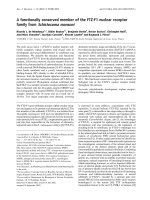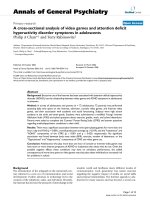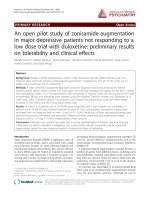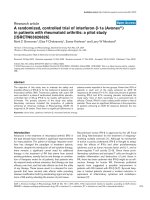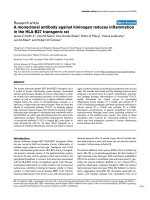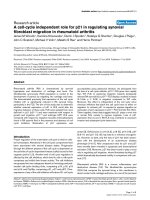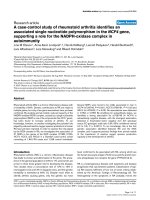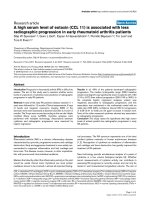Báo cáo y học: " A phase 1 trial of nebulised heparin in acute lung injury" ppt
Bạn đang xem bản rút gọn của tài liệu. Xem và tải ngay bản đầy đủ của tài liệu tại đây (578.59 KB, 8 trang )
Open Access
Available online />Page 1 of 8
(page number not for citation purposes)
Vol 12 No 3
Research
A phase 1 trial of nebulised heparin in acute lung injury
Barry Dixon
1
, John D Santamaria
1
and Duncan J Campbell
2
1
Department of Intensive Care, St Vincent's Hospital, 41 Victoria Parade, Melbourne 3065, Australia
2
StVincent's Institute of Medical Research, 41 Victoria Parade, Melbourne 3065, Australia
Corresponding author: Barry Dixon,
Received: 12 Feb 2008 Revisions requested: 20 Mar 2008 Revisions received: 2 Apr 2008 Accepted: 6 May 2008 Published: 6 May 2008
Critical Care 2008, 12:R64 (doi:10.1186/cc6894)
This article is online at: />© 2008 Dixon et al.; licensee BioMed Central Ltd.
This is an open access article distributed under the terms of the Creative Commons Attribution License ( />),
which permits unrestricted use, distribution, and reproduction in any medium, provided the original work is properly cited.
Abstract
Introduction Animal studies of acute lung injury (ALI) suggest
nebulised heparin may limit damage from fibrin deposition in the
alveolar space and microcirculation. No human studies have
been undertaken to date. We assessed the feasibility, safety and
potential anticoagulant effects of administration of nebulised
heparin to patients with ALI.
Methods An open label phase 1 trial of four escalating doses of
nebulised heparin was performed. A total of 16 ventilated
patients with ALI were studied. The first group was administered
a total of 50,000 U/day, the second group 100,000 U/day, the
third group 200,000 U/day and the fourth group 400,000 U/
day. Assessments of lung function included the PaO
2
/FiO
2
ratio,
lung compliance and the alveolar dead space fraction.
Monitoring of anticoagulation included the activated partial
thromboplastin time (APTT) and the thrombin clotting time.
Bronchoalveolar lavage fluid was collected and the prothrombin
fragment and tissue plasminogen activator levels were
assessed. Analysis of variance was used to compare the effects
of dose.
Results No serious adverse events occurred for any dose. The
changes over time for the PaO
2
/FiO
2
ratio, lung compliance and
the alveolar dead space fraction levels were similar for all doses.
A trend to increased APTT and thrombin clotting time levels was
present with higher doses (P = 0.09 and P = 0.1, respectively).
For the highest dose, the APTT reached 64 seconds; following
cessation of nebulised heparin, the APTT fell to 39 seconds (P
= 0.06). In bronchoalveolar lavage samples a trend to reduced
prothrombin fragment levels was present with higher doses (P
= 0.1), while tissue plasminogen activator levels were similar for
all doses.
Conclusion Administration of nebulised heparin to mechanically
ventilated patients with ALI is feasible. Nebulised heparin was
not associated with any serious adverse events, and at higher
doses it increased APTT levels. Larger trials are required to
further investigate the safety and efficacy of nebulised heparin.
In these trials due consideration must be given to systemic
anticoagulant effects.
Trial registration Australian Clinical trials registry
ACTRN12606000388516.
Introduction
Acute lung injury (ALI) is a serious clinical problem. Estimates
are that 190,600 cases of ALI develop in the United States
each year, which are associated with 74,500 deaths and 3.6
million hospital days [1]. The 28-day mortality for ALI is 32%
[2]. There is currently no method to prevent or treat ALI
ALI is characterised by the rapid onset of respiratory distress
in the setting of an inflammatory insult to the lungs [3,4].
Inflammatory insults include sepsis, trauma, hypotension, car-
diopulmonary bypass, pancreatitis, aspiration and multiple
transfusions. Septic insults are by the commonest cause of
ALI. Pneumonia triggers 30% of cases, and sepsis elsewhere
in the body causes 32% of cases [2]
One mechanism by which inflammation causes ALI is deposi-
tion of fibrin in the alveolar space and microcirculation. Fibrin
deposition in the alveolar sacs gives rise to a hyaline mem-
brane, and deposition in the microvasculature results in throm-
bosis [5-14]. Nebulised heparin may limit fibrin deposition in
the alveolar space and microcirculation through heparin's anti-
coagulant and fibrinolytic actions [15-18]. Studies in animal
models of ALI have demonstrated that nebulised heparin
improved the PaO
2
/FiO
2
ratio and reduced histological
ALI = acute lung injury; APTT = activated partial thromboplastin time; BAL = bronchoalveolar lavage; ELISA = enzyme-linked immunosorbent assay;
PaO
2
/FiO
2
= arterial oxygen partial pressure to inspired oxygen fraction ratio; PTF = prothrombin fragments; TCT = thrombin clotting time; t-PA =
tissue plasminogen activator.
Critical Care Vol 12 No 3 Dixon et al.
Page 2 of 8
(page number not for citation purposes)
damage [19,20]. In addition, in the setting of lung injury trig-
gered by cardiac surgery, a preoperative heparin infusion
reduced evidence of pulmonary microvascular thrombosis
[21].
We are unaware of previous trials of nebulised heparin in
patients with ALI. We therefore undertook the present trial to
assess the feasibility, safety and potential anticoagulant
effects of nebulised heparin in mechanically ventilated patients
with ALI. In addition, we assessed the effects on intrapulmo-
nary coagulation activation and fibrinolysis.
Materials and methods
The study was approved by the St Vincent's Hospital Human
Research Ethics Committee. Consent was obtained from the
patient or next of kin before participation in the study.
The present study was an open-label, escalating-dosage
phase 1 trial of nebulised heparin (heparin sodium, 25,000 U/
ml; CP Pharmaceuticals Ltd, Wrexham, UK) in mechanically
ventilated patients with ALI. Four doses were studied. Each
dose was assessed in four patients over 2 days. The first
group was administered 50,000 U/day, as 25,000 U 12 hourly
(four nebulisations); the second group received 100,000 U/
day, as 50,000 U 12 hourly (four nebulisations); the third
group received 200,000 U/day, as 100,000 U 12 hourly (four
nebulisations); and the fourth group was administered
400,000 U/day, as 100,000 U 6 hourly (eight nebulisations).
The final nebulisation of heparin was administered at 36 hours
from baseline in the 50,000 U/day, 100,000 U/day and
200,000 U/day groups, and at 42 hours in the 400,000 U/day
group.
Subjects
We studied patients admitted to the intensive care unit that
met the following inclusion and exclusion criteria.
The inclusion criterion was the initiation of mechanical ventila-
tion for acute respiratory dysfunction characterised by a PaO
2
/
FiO
2
ratio < 300 mmHg, where the acute respiratory dysfunc-
tion was primarily due to a direct or indirect inflammatory insult
to the lung.
The exclusion criteria were > 48 hours since the inclusion cri-
terion was met; hypoxemia predominantly due to a cause other
than ALI, such as congestive heart failure, pulmonary embo-
lism, chronic obstructive airways disease or asthma; systemic
anticoagulation (including activated protein C), potential need
for haemofiltration and therefore anticoagulation; pulmonary
haemorrhage in the previous 3 months, uncontrolled bleeding,
significant bleeding disorder; allergy to heparin, including
heparin-induced thrombocytopenia; age < 18 years or > 85
years; patient unlikely to survive 96 hours; bronchoscopy not
possible due to severe hypoxia; previous intubation and venti-
lation during current admission; noninvasive ventilation for
more than 36 hours prior to intubation; or pregnancy.
Nebulisation
Heparin was nebulised with an Aeroneb Pro Nebulizer (Aero-
gen Ltd, Galway, Ireland) over 30 minutes. The nebuliser was
placed in the inspiratory line 12 cm from the Y of the circuit.
The heat and moisture exchanger was removed during nebuli-
sation. Patients were ventilated in a pressure-support mode of
ventilation and upper pressure levels were maintained at or
below 35 cmH
2
O.
Lung function
The P
a
O
2
/F
i
O
2
ratio, lung compliance and the alveolar dead
space fraction were measured at baseline and at 2, 6, 10, 14,
18, 22, 26, 30, 34, 28, 42 and 46 hours. We measured the
alveolar dead space fraction because previous studies have
suggested this variable may reflect the extent of microvascular
thrombosis in ALI [21,22]. Evidence of blood staining of respi-
ratory secretions was assessed by the bedside nurse follow-
ing routine pulmonary suctioning.
Anticoagulant effects
The activated partial thromboplastin time (APTT) and the
thrombin clotting time (TCT) were assessed at the same time
points as those of lung function, and at 50, 54 and 58 hours in
the 400,000 U/day group.
Lung haemostatic responses
Prothrombin fragments (PTF) and tissue plasminogen activa-
tor (t-PA) levels in bronchoalveolar lavage (BAL) fluid were
assessed at baseline and following the final nebulisation (BAL
was undertaken on average 7.6 ± 5 hours following the final
nebulisation).
Lung compliance and alveolar dead space fraction
Standard formulae were used to calculate lung compliance.
The alveolar dead space fraction was measured with the
Cosmo Plus Respironics monitor (Novametrix Medical Sys-
tems, Wallingford, CT, USA) [21].
Bronchoalveolar lavage
The bronchoscope was wedged in the distal airway. The initial
25 ml of warm saline injected was discarded. Five further 25
ml aliquots were instilled and aspirated. A portion of the aspi-
rated fluid was spun at 1,500 × g for 10 minutes at 4°C. The
supernatant was stored at -80°C. Samples were assayed by
ELISAs for PTF levels (Enzygnost F1 + 2 monoclonal assays;
Behring, Marburg, Germany) and for t-PA antigen levels (Tin-
tElize tPA, Biopool International, Ventura, CA, USA).
Statistical analysis
Based on previous studies we determined that four patients in
each group would be adequate to detect a major anticoagu-
lant effect [23,24]. Analysis of variance was used to compare
Available online />Page 3 of 8
(page number not for citation purposes)
the effect of heparin dose on the P
a
O
2
/F
i
O
2
ratio, lung compli-
ance, the alveolar dead space fraction, the APTT, the TCT and
intrapulmonary PTF and t-PA levels. Fisher's exact test com-
pared categorical variables. Student's t test compared nor-
mally distributed variables.
Data are reported as the mean ± standard deviation. Statistical
analysis was performed with the JMP program (SAS Institute,
Inc., Cary, NC, USA).
Results
Patient characteristics
Sixteen patients were enrolled. The mean patient age was 58
± 14 years, and the Acute Physiology and Chronic Health
Evaluation Score II was 21 ± 7. The baseline P
a
O
2
/F
i
O
2
ratio
was 183 ± 66 mmHg, lung compliance was 26 ± 14 ml/
cmH
2
O and the alveolar dead space fraction was 0.23 ± 0.1.
Prophylactic subcutaneous heparin was administered to 14 of
the 16 patients studied. The commonest aetiological factor for
ALI was pneumonia (Table 1). The time from intubation to initial
heparin nebulisation was 22 ± 15 hours. The mean mechani-
cal ventilation time was 10 ± 9 days, the intensive care length
of stay was 12 ± 8 days and the hospital length of stay was 28
± 14 days. The tracheostomy rate was 63% and the hospital
mortality was 43%.
Table 1
Baseline and microbiological characteristics of patients
Variable Dose Combined n (%)
50,000 U/day 100,000 U/day 200,000 U/day 400,000 U/day
Number of patients 444416
Age (years) 57.7 ± 17.3 61.3 ± 14.2 54.3 ± 17.6 60.0 ± 13.0 58.3 ± 14.3
Male 21418 (50)
Acute Physiological and Chronic Health Evaluation II
score
22.3 ± 6.0 21.8 ± 8.7 18.3 ± 10 20.0 ± 3.4 20.6 ± 7.0
Subcutaneous heparin 434314 (88)
Arterial to inspired oxygen ratio (mmHg) 159 ± 37 143 ± 48 207 ± 79 226 ± 75 183 ± 66
Lung compliance (ml/cmH
2
O) 30 ± 7 19 ± 5 37 ± 21 22 ± 14 26 ± 14
Alveolar dead space fraction 0.15 ± 0.04 0.3 ± 0.10 0.17 ± 0.07 0.24 ± 0.1 0.23 ± 0.1
Creatinine (μmol/l) 80 ± 45 56 ± 14 130 ± 154 97 ± 45 91 ± 80
Activated partial thromboplastin time (s) 38 ± 7 37 ± 6 44 ± 7 47 ± 20 41 ± 11
Thrombin clotting time (s) 17 ± 2 21 ± 3 20 ± 10 19 ± 3 19 ± 5
Acute lung injury cause
Pneumonia 332210 (63)
Sepsis 00112 (13)
Pancreatitis 01012 (13)
Empyema 10102 (13)
Aspiration 00000
Surgical admission 30126 (38)
Microbiology
Gram-negative 10214 (25)
Gram-positive 12104 (25)
Other 01023 (19)
No pathogen detected 21115 (31)
Blood culture-positive 00112 (12)
Critical Care Vol 12 No 3 Dixon et al.
Page 4 of 8
(page number not for citation purposes)
Lung function
The changes over time in the P
a
O
2
/F
i
O
2
ratio, lung compliance
and the alveolar dead space fraction were similar for all doses
studied. There were no statistically significant differences
found for the dosage or for the interaction between dosage
and time (Figures 1 to 3).
One patient in the 400,000 U/day group developed blood-
stained respiratory secretions after the seventh dose. This was
not associated with any deterioration in lung function. The
blood staining resolved following withdrawal of nebulised
heparin.
Anticoagulant effects
The mean APTT for each group following the final nebulisation,
in order of increasing dose, was 34 seconds (normal range <
35 seconds), 41 seconds, 48 seconds and 64 seconds (P =
0.09, analysis of variance, comparison by dose) (Figure 4). The
mean TCT for each group following the final nebulisation, in
order of increasing dose, was 18 seconds (normal range < 21
seconds), 23 seconds, 50 seconds and 48 seconds (P = 0.1,
analysis of variance, comparison by dose) (Figure 5). For the
higher dose groups, both the APTT and TCT fell following ces-
sation of nebulised heparin. For the highest dose, the APTT fell
from 64 seconds to 39 seconds (P = 0.06) (Figure 4).
Bronchoalveolar lavage
The PTF levels in BAL fluid in the 50,000 U/day group were
higher following the final nebulisation, while in the 100,000 U/
day, 200,000 U/day and 400,000 U/day groups the PTF lev-
els remained similar to baseline levels following the final
nebulisation (P = 0.1, analysis of variance, comparison by
dose) (Figure 6). The t-PA levels were similar to baseline levels
for all doses following the final nebulisation (Figure 7).
Figure 1
Changes in arterial to inspired oxygen ratio with nebulised heparin dosageChanges in arterial to inspired oxygen ratio with nebulised heparin dosage. Percentage change from baseline in the arterial to inspired oxygen ratio
(P
a
O
2
/F
i
O
2
) (mean ± standard deviation).
Figure 2
Changes in lung compliance with nebulised heparin dosageChanges in lung compliance with nebulised heparin dosage. Percentage change from baseline in the lung compliance over time for each dose
(mean ± standard deviation).
Available online />Page 5 of 8
(page number not for citation purposes)
Figure 3
Changes in alveolar dead space fraction with nebulised heparin dosageChanges in alveolar dead space fraction with nebulised heparin dosage. Percentage change from baseline in the alveolar dead space fraction
(ADSF) (mean ± standard deviation).
Figure 4
Changes in activated partial thromboplastin time with nebulised heparin dosageChanges in activated partial thromboplastin time with nebulised heparin dosage. Upper: Change in the activated partial thromboplastin time (APTT)
over time. The last dose of heparin was given at 36 hours for all groups except the 400,000 U/day group, in which it was administered at 42 hours
(mean levels; P = 0.06, comparison of 46-hour and 58-hour timepoints in the 400,000 U/day group). Lower: APTT at baseline and following the final
dose of nebulised heparin (P = 0.09, analysis of variance comparison by dose, mean and standard deviation).
Critical Care Vol 12 No 3 Dixon et al.
Page 6 of 8
(page number not for citation purposes)
Figure 5
Changes in thrombin clotting time with nebulised heparin dosageChanges in thrombin clotting time with nebulised heparin dosage. Upper: Change in the thrombin clotting time (TCT) over time. The last dose of
heparin was given at 36 hours for all groups except the 400,000 U/day group, in which it was administered at 42 hours (mean levels). Lower: TCT at
baseline and following the final dose of nebulised heparin (P = 0.1, analysis of variance comparison by dose, mean and standard deviation).
Figure 6
Comparison of prothrombin fragment levels in bronchoalveolar fluid with nebulised heparin dosageComparison of prothrombin fragment levels in bronchoalveolar fluid
with nebulised heparin dosage. Comparison of prothrombin fragment
(PTF) levels in bronchoalveolar fluid. Levels were assessed at baseline
and following the final dose of nebulised heparin (P = 0.1, analysis of
variance comparison by dose, mean and standard deviation).
Figure 7
Comparison of tissue plasminogen activator levels in bronchoalveloar fluid with nebulised heparin dosageComparison of tissue plasminogen activator levels in bronchoalveloar
fluid with nebulised heparin dosage. Comparison of tissue plasminogen
activator (t-PA) levels in bronchoalveloar fluid. Levels were assessed at
baseline and following the final dose of nebulised heparin (mean and
standard deviation).
Available online />Page 7 of 8
(page number not for citation purposes)
Discussion
We assessed the feasibility, safety and potential anticoagulant
effects of nebulised heparin in mechanically ventilated patients
with ALI. We found administration of nebulised heparin to
mechanically ventilated patients with ALI was feasible, was not
associated with serious adverse events, and increased APTT
levels at higher doses.
The changes in the PaO
2
/FiO
2
ratio, lung compliance and the
alveolar dead space fraction were similar for all doses. In one
patient in the 400,000 U/day group, blood staining of the res-
piratory secretions was present after the seventh dose. This
staining resolved following withdrawal of heparin.
We found evidence of dose-dependent effects on APTT and
TCT levels. For the 50,000 U/day group, the levels remained
within the normal range; however, for the 100,000 U/day,
200,000 U/day and 400,000 U/day groups, the APTT and
TCT levels were raised on the second day. Peak levels were
reached following the final nebulisation, and thereafter levels
fell. For the 400,000 U/day group, the APTT reached the
therapeutic range (64 seconds) and fell acutely to 39 seconds
following cessation of nebulised heparin.
Previous clinical studies have investigated the potential of sys-
temic anticoagulation using nebulised heparin – to date, with-
out success [23,24]. Unlike these studies we used repeated
doses of nebulised heparin. Our finding that the APTT and
TCT levels increased only after repeated doses suggests that
pulmonary processes, such as storage of heparin in endothe-
lial cells and metabolism by heparinases, may initially limit
heparin reaching the systemic circulation. These processes
may, however, become saturated following repeated heparin
doses [25]. In future trials of nebulised heparin, due consider-
ation must be given to this systemic anticoagulant effect.
We also examined whether nebulised heparin limited coagula-
tion and increased fibrinolysis in the lungs. For the 50,000 U/
day group, the PTF levels in BAL fluid doubled from baseline
levels following the final nebulisation. For the 100,000 U/day,
200,000 U/day and 400,000 U/day groups, however, the PTF
levels did not increase. Previous trials in patients with venti-
lated-associated pneumonia also found a doubling of
coagulation levels in BAL fluid over the first few days [26,27].
While inconclusive, our findings raise the possibility that neb-
ulised heparin, at higher doses, limited coagulation activation
in the lungs. Nebulised heparin did not increase t-PA levels in
BAL fluid for any of the doses studied.
One of the strengths of the present study was the nebulisation
system used. The evidence of a dose-related effect on sys-
temic APTT and TCT levels suggested significant amounts of
heparin reached the alveolar spaces. This finding is consistent
with previous studies [28]. Another strength of the study was
the inclusion of genuinely high-risk patients with ALI. The aver-
age P
a
O
2
/F
i
O
2
ratio at baseline was 183 mmHg, the tracheos-
tomy rate was 63% and the hospital mortality was 43%.
Limitations of the present study included the absence of a con-
trol group, the small number of patients enrolled and the rela-
tively short time (2 days) over which heparin was nebulised.
The size of the study reflected the need for caution, as neb-
ulised heparin had not previously been administered to
patients with ALI. Furthermore, we determined that four
patients in each group would provide adequate power to
detect a major anticoagulant effect. Our study was conse-
quently too small to draw conclusions regarding efficacy or
potential infrequent deleterious effects.
Previous studies in animal models of ALI have demonstrated
significant improvements in pulmonary function with inhaled
heparin and other glycosaminoglycans [19,20,29]. Heparin
has a range of anticoagulant actions and also promotes fibri-
nolysis through increased t-PA levels [15-18]. Compared with
the intravenous route, nebulisation delivers high concentra-
tions of heparin to the alveolar space with a reduced risk of
adversely effecting systemic coagulation.
Conclusion
Administration of nebulised heparin to mechanically ventilated
patients with ALI is feasible. The heparin administration was
not associated with any serious adverse events, and increased
APTT levels at higher doses. Larger trials are required to fur-
ther investigate the safety and efficacy of nebulised heparin in
ALI. In these trials, due consideration must be given to sys-
temic anticoagulant effects.
Competing interests
The authors declare that they have no competing interests.
Authors' contributions
BD designed the study, collected the data, performed the sta-
tistical analysis and drafted the manuscript. JDS and DJC par-
ticipated in its design, and coordinated and helped to draft the
manuscript. All authors read and approved the final
manuscript.
Acknowledgements
The present study was supported by the St Vincent's Hospital Research
Endowment Fund and the Intensive Care Foundation. The funding bod-
Key messages
• Administration of nebulised heparin to mechanically
ventilated patients with ALI is feasible and was not
associated with any serious adverse events.
• At higher doses, nebulised heparin increased APTT lev-
els.
• Larger trials are required to further investigate the safety
and efficacy of nebulised heparin in ALI.
Critical Care Vol 12 No 3 Dixon et al.
Page 8 of 8
(page number not for citation purposes)
ies had no role in the study design, data collection, analysis and interpre-
tation of the data or in the writing and publication of the manuscript.
References
1. Rubenfeld GD, Caldwell E, Peabody E, Weaver J, Martin DP, Neff
M, Stern EJ, Hudson LD: Incidence and outcomes of acute lung
injury. N Engl J Med 2005, 353:1685-1693.
2. Bersten AD, Edibam C, Hunt T, Moran J: Incidence and mortality
of acute lung injury and the acute respiratory distress syn-
drome in three Australian States. Am J Respir Crit Care Med
2002, 165:443-448.
3. Ware LB, Matthay MA: The acute respiratory distress
syndrome. N Engl J Med 2000, 342:1334-1349.
4. Bernard GR, Artigas A, Brigham KL, Carlet J, Falke K, Hudson L,
Lamy M, Legall JR, Morris A, Spragg R: The American-European
Consensus Conference on ARDS. Definitions, mechanisms,
relevant outcomes, and clinical trial coordination. Am J Respir
Crit Care Med 1994, 149:818-824.
5. Blaisdell FW: Pathophysiology of the respiratory distress
syndrome. Arch Surg 1974, 108:44-49.
6. Nicholls JM, Poon LL, Lee KC, Ng WF, Lai ST, Leung CY, Chu CM,
Hui PK, Mak KL, Lim W, Yan KW, Chan KH, Tsang NC, Guan Y,
Yuen KY, Peiris JS: Lung pathology of fatal severe acute respi-
ratory syndrome. Lancet 2003, 361:1773-1778.
7. Scully RE, Galdabini JJ, McNeely BU: Case records of the Mas-
sachusetts General Hospital. Weekly clinicopathological exer-
cises. Case 22 – 1977. N Engl J Med 1977, 296:1279-1287.
8. Dairaku M, Sueishi K, Tanaka K: Disseminated intravascular
coagulation in newborn infants. Prevalence in autopsies and
significance as a cause of death. Pathol Res Pract 1982,
174:106-115.
9. Tomashefski JF Jr, Davies P, Boggis C, Greene R, Zapol WM, Reid
LM: The pulmonary vascular lesions of the adult respiratory
distress syndrome. Am J Pathol 1983, 112:112-126.
10. Bone RC, Francis PB, Pierce AK: Intravascular coagulation
associated with the adult respiratory distress syndrome. Am J
Med 1976, 61:585-589.
11. Hill JD, Ratliff JL, Parrott JC, Lamy M, Fallat RJ, Koeniger E, Yaeger
EM, Whitmer G: Pulmonary pathology in acute respiratory
insufficiency: lung biopsy as a diagnostic tool. J Thorac Cardi-
ovasc Surg
1976, 71:64-71.
12. Saldeen T: The microembolism syndrome. Forensic Sci 1972,
1:179-187.
13. Archer L: Pathological manifestations of septic shock. In Hand-
book of Endotoxin Volume 4. Edited by: Proctor RA. Elsevier Sci-
ence Publishers; Philadelphia, PA, USA; 1986.
14. Yoshikawa T, Tanaka KR, Guze LB: Infection and disseminated
intravascular coagulation. Medicine 1971, 50:237-258.
15. Cadroy Y, Gaspin D, Dupouy D, Lormeau JC, Boneu B, Sie P:
Heparin reverses the procoagulant properties of stimulated
endothelial cells. Thromb Haemost 1996, 75:190-195.
16. Gori AM, Pepe G, Attanasio M, Falciani M, Abbate R, Prisco D,
Fedi S, Giusti B, Brunelli T, Comeglio P, Gensini GF, Neri Serneri
GG: Tissue factor reduction and tissue factor pathway inhibi-
tor release after heparin administration. Thromb Haemost
1999, 81:589-593.
17. Pepe G, Giusti B, Attanasio M, Gori AM, Comeglio P, Martini F,
Gensini G, Abbate R, Neri Serneri GG: Tissue factor and plas-
minogen activator inhibitor type 2 expression in human stimu-
lated monocytes is inhibited by heparin. Semin Thromb
Hemost 1997, 23:135-141.
18. Marsh NA, Minter AJ, Chesterman CN: The effect of heparin and
other glycosaminoglycans on levels of tissue plasminogen
activator and plasminogen activator inhibitor in cultured
human umbilical vein endothelial cells. Blood Coagul
Fibrinolysis 1990, 1:133-138.
19. Murakami K, McGuire R, Cox RA, Jodoin JM, Bjertnaes LJ, Katahira
J, Traber LD, Schmalstieg FC, Hawkins HK, Herndon DN, Traber
DL: Heparin nebulization attenuates acute lung injury in sepsis
following smoke inhalation in sheep. Shock 2002, 18:236-241.
20. Gunther A, Lubke N, Ermert M, Schermuly RT, Weissmann N,
Breithecker A, Markart P, Ruppert C, Quanz K, Ermert L, Grim-
minger F, Seeger W: Prevention of bleomycin-induced lung
fibrosis by aerosolization of heparin or urokinase in rabbits.
Am J Respir Crit Care Med 2003, 168:1358-1365.
21. Dixon B, Campbell DJ, Santamaria JD: Elevated pulmonary dead
space and coagulation abnormalities suggest lung microvas-
cular thrombosis in patients undergoing cardiac surgery.
Intensive Care Med 2008 in press.
22. Nuckton TJ, Alonso JA, Kallet RH, Daniel BM, Pittet JF, Eisner MD,
Matthay MA: Pulmonary dead-space fraction as a risk factor for
death in the acute respiratory distress syndrome. N Engl J
Med 2002, 346:1281-1286.
23. Bendstrup KE, Gram J, Jensen JI: Effect of inhaled heparin on
lung function and coagulation in healthy volunteers. Eur Respir
J 2002, 19:606-610.
24. Harenberg J, Malsch R, Angelescu M, Lange C, Michaelis HC,
Wolf H, Heene DL: Anticoagulant effects and tissue factor
pathway inhibitor after intrapulmonary low-molecular-weight
heparin. Blood Coagul Fibrinol 1996, 7:477-483.
25. Mahadoo J, Hiebert LM, Jaques LB, Wright CJ: Endothelial
sequestration of heparin administered by the intrapulmonary
route. Artery 1980, 7:438-447.
26. El Solh AA, Choi G, Schultz MJ, Pineda LA, Mankowski C: Clinical
and hemostatic responses to treatment in ventilator-associ-
ated pneumonia: role of bacterial pathogens. Crit Care Med
2007, 35:490-496.
27. Schultz MJ, Millo J, Levi M, Hack CE, Weverling GJ, Garrard CS,
Poll T van der: Local activation of coagulation and inhibition of
fibrinolysis in the lung during ventilator associated
pneumonia. Thorax 2004, 59:130-135.
28. Bendstrup KE, Chambers CB, Jensen JI, Newhouse MT: Lung
deposition and clearance of inhaled (99m)Tc-heparin in
healthy volunteers. Am J Respir Crit Care Med 1999,
160:1653-1658.
29. Bryan R, Feldman M, Jawetz SC, Rajan S, DiMango E, Tang HB,
Scheffler L, Speert DP, Prince A: The effects of aerosolized dex-
tran in a mouse model of Pseudomonas aeruginosa pulmo-
nary infection. J Infect Dis 1999, 179:1449-1458.
